Method for Determining Displacement and Characterizing Spatial Kinematic Misalignment in a Rigid Exoskeleton
Abstract
1. Introduction
1.1. Anthropometric Adaptation
1.2. Self-Aligning Joints
1.3. Research Gap
2. Mathematical Foundation
2.1. Consideration of a 2D Plane
2.2. Calculations in 3D Space
3. Practical Implementation
3.1. Implemented Sensors and Required Modifications
3.2. Constructive Adaptations
4. Experimental Validation
4.1. Mock-Up Introductions
4.2. Procedure
5. Findings
6. Use in Application
6.1. Study Procedure
6.2. Evaluation and Implication
6.3. Practical Limitation
7. Conclusions and Outlook
Author Contributions
Funding
Data Availability Statement
Conflicts of Interest
Nomenclature
| ROM | Range of motion |
| DOF | Degree of freedom |
| COR | Center of rotation |
| KCF | Exoskeleton’s kinematic coordinate frame |
| r | Distance between the center of rotation M and the contact point P |
| M | Center of rotation of the human joint |
| Spatial misalignment between the axes of the exoskeleton and the human joint | |
| Relative distance to the current interface location | |
| Initial length, i.e., distance to the initial position of the interface | |
| Compensated relative axial displacement | |
| Angle of rotation to the contact point | |
| Relative angular deviation between the human and the interface during the rotation | |
| Additional angle of rotation to the contact point in 3D | |
| Measured contact point between the exoskeleton and the human | |
| Cartesian coordinates of the center of rotation M (KCF) | |
| Cartesian coordinates of the measured contact point (KCF) | |
| DOF A | Exoskeleton’s translational degree of freedom for measuring and compensating for the offset |
| DOF I | Exoskeleton’s transverse axis of rotation, angle quantified by |
| DOF | Exoskeleton’s longitudinal axis of rotation, angle quantified by |
References
- Casla, P.; Larreina, J.; Fletcher, S.; Johnson, T.; Parigot, L.; Otero, M.; Adlon, T.; Riegauf, A.; Marguglio, A.; Kaasinen, E.; et al. Human-Centered Factories from Theory to Industrial Practice. Lessons Learned and Recommendations; humAn CEntred Factories (ACE): Brussels, Belgium, 2019. [Google Scholar]
- Mark, B.G.; Rauch, E.; Matt, D.T. Worker assistance systems in manufacturing: A review of the state of the art and future directions. J. Manuf. Syst. 2021, 59, 228–250. [Google Scholar] [CrossRef]
- de Looze, M.P.; Bosch, T.; Krause, F.; Stadler, K.S.; O’Sullivan, L.W. Exoskeletons for industrial application and their potential effects on physical work load. Ergonomics 2016, 59, 671–681. [Google Scholar] [CrossRef] [PubMed]
- Pech, M.; Vrchota, J. The Product Customization Process in Relation to Industry 4.0 and Digitalization. Processes 2022, 10, 539. [Google Scholar] [CrossRef]
- Eurofound; Wilczynska, A.; Cabrita, J.; Parent-Thirion, A.; Biletta, I.; Vargas, O.; Wilkens, M.; Vermeylen, G. 6th European Working Conditions Survey—2017 Update; Publications Office: Luxembourg, 2017. [Google Scholar] [CrossRef]
- Ralfs, L.; Hoffmann, N.; Weidner, R. Method and Test Course for the Evaluation of Industrial Exoskeletons. Appl. Sci. 2021, 11, 9614. [Google Scholar] [CrossRef]
- European Agency for Safety and Health at Work; IKEI; Panteia; Kok, J.d.; Vroonhof, P.; Snijders, J.; Roullis, G.; Clarke, M.; Peereboom, K.; Dorst, P.v.; et al. Work-Related Musculoskeletal Disorders—Prevalence, Costs and Demographics in the EU; Publications Office: Luxembourg, 2019. [Google Scholar] [CrossRef]
- de La Tejera, J.A.; Bustamante-Bello, R.; Ramirez-Mendoza, R.A.; Izquierdo-Reyes, J. Systematic Review of Exoskeletons towards a General Categorization Model Proposal. Appl. Sci. 2021, 11, 76. [Google Scholar] [CrossRef]
- Mark, B.G.; Rauch, E.; Matt, D.T. Systematic selection methodology for worker assistance systems in manufacturing. Comput. Ind. Eng. 2022, 166, 107982. [Google Scholar] [CrossRef]
- Maurice, P.; Camernik, J.; Gorjan, D.; Schirrmeister, B.; Bornmann, J.; Tagliapietra, L.; Latella, C.; Pucci, D.; Fritzsche, L.; Ivaldi, S.; et al. Objective and Subjective Effects of a Passive Exoskeleton on Overhead Work. IEEE Trans. Neural Syst. Rehabil. Eng. A Publ. IEEE Eng. Med. Biol. Soc. 2020, 28, 152–164. [Google Scholar] [CrossRef]
- Schmalz, T.; Schändlinger, J.; Schuler, M.; Bornmann, J.; Schirrmeister, B.; Kannenberg, A.; Ernst, M. Biomechanical and Metabolic Effectiveness of an Industrial Exoskeleton for Overhead Work. Int. J. Environ. Res. Public Health 2019, 16, 4792. [Google Scholar] [CrossRef]
- Liang, J.; Zhang, Q.; Liu, Y.; Wang, T.; Wan, G. A review of the design of load-carrying exoskeletons. Sci. China. Technol. Sci. 2022, 65, 2051–2067. [Google Scholar] [CrossRef]
- Ott, O.; Ralfs, L.; Weidner, R. Framework for qualifying exoskeletons as adaptive support technology. Front. Robot. AI 2022, 9, 951382. [Google Scholar] [CrossRef]
- Näf, M.B.; Junius, K.; Rossini, M.; Rodriguez-Guerrero, C.; Vanderborght, B.; Lefeber, D. Misalignment Compensation for Full Human-Exoskeleton Kinematic Compatibility: State of the Art and Evaluation. Appl. Mech. Rev. 2018, 70, 050802. [Google Scholar] [CrossRef]
- Xiloyannis, M.; Alicea, R.; Georgarakis, A.M.; Haufe, F.L.; Wolf, P.; Masia, L.; Riener, R. Soft Robotic Suits: State of the Art, Core Technologies, and Open Challenges. IEEE Trans. Robot. 2022, 38, 1343–1362. [Google Scholar] [CrossRef]
- Goršič, M.; Song, Y.; Dai, B.; Novak, V.D. Short-term effects of the Auxivo LiftSuit during lifting and static leaning. Appl. Ergon. 2022, 102, 103765. [Google Scholar] [CrossRef]
- Lindemann, U.; Krespach, J.; Daub, U.; Schneider, M.; Sczuka, K.S.; Klenk, J. Effect of a Passive Exosuit on Sit-to-Stand Performance in Geriatric Patients Measured by Body-Worn Sensors-A Pilot Study. Sensors 2023, 23, 1032. [Google Scholar] [CrossRef]
- Lei, T.; Seo, J.; Liang, K.; Xu, J.; Li, H.; Zhou, Y.; Khan, M.; Heung, K.H. Lightweight Active Soft Back Exosuit for Construction Workers in Lifting Tasks. J. Constr. Eng. Manag. 2024, 150, 04024073. [Google Scholar] [CrossRef]
- Bajpai, A.; Carrasquillo, C.; Carlson, J.; Park, J.; Iyengar, D.; Herrin, K.; Young, A.J.; Mazumdar, A. Design and Validation of a Versatile High Torque Quasidirect Drive Hip Exoskeleton. IEEE/ASME Trans. Mechatron. 2024, 29, 789–797. [Google Scholar] [CrossRef]
- Park, D.; Toxiri, S.; Chini, G.; Di Natali, C.; Caldwell, D.G.; Ortiz, J. Shoulder-sideWINDER (Shoulder-side Wearable INDustrial Ergonomic Robot): Design and Evaluation of Shoulder Wearable Robot With Mechanisms to Compensate for Joint Misalignment. IEEE Trans. Robot. 2022, 38, 1460–1471. [Google Scholar] [CrossRef]
- Weidner, R.; Karafillidis, A. Distinguishing Support Technologies. A General Scheme and Its Application to Exoskeletons. In Developing Support Technologies. Biosystems & Biorobotics; Karafillidis, A., Weidner, R., Eds.; Springer International Publishing: Cham, Switzerland, 2018; Volume 23, pp. 85–100. [Google Scholar] [CrossRef]
- Auxivo, A.G. CarrySuit—The Upper Body Exoskeleton. 2024. Available online: https://www.auxivo.com/carrysuit (accessed on 18 December 2024).
- SuitX. IX SHOULDER AIR Exoskeleton. 2024. Available online: https://www.suitx.com/de/produkte/ix-shoulder-air-exoskelett (accessed on 18 December 2024).
- Lockheed Martin. Let the FORTIS® Tool Arm Give You a Hand. 2017. Available online: https://news.lockheedmartin.com/2017-04-20-Let-the-FORTIS-R-Tool-Arm-Give-You-a-Hand (accessed on 18 December 2024).
- SuitX. IX BACK Exoskeleton. 2024. Available online: https://www.suitx.com/de/produkte/ix-back-exoskelett (accessed on 18 December 2024).
- Levitate Technologies. Airframe Exoskeleton. 2024. Available online: https://www.levitatetech.com/airframe/ (accessed on 18 December 2024).
- Comau. Wearable Robotics—MATE XT Exoskeleton. 2024. Available online: https://www.comau.com/en/our-offer/products-and-solutions/wearable-robotics-exoskeletons/wearable-robotics-mate-xt-exoskeleton/ (accessed on 18 December 2024).
- Yoon, J.; Kim, S.; Moon, J.; Kim, J.; Lee, G. Minimizing Misalignment and Frame Protrusion of Shoulder Exoskeleton via Optimization for Reducing Interaction Force and Minimizing Volume. Machines 2022, 10, 1223. [Google Scholar] [CrossRef]
- Pons, J.L. Wearable Robots: Biomechatronic Exoskeletons; John Wiley & Sons: Hoboken, NJ, USA, 2008. [Google Scholar]
- Schiele, A.; van der Helm, F.C.T. Kinematic design to improve ergonomics in human machine interaction. IEEE Trans. Neural Syst. Rehabil. Eng. A Publ. IEEE Eng. Med. Biol. Soc. 2006, 14, 456–469. [Google Scholar] [CrossRef]
- Zanotto, D.; Akiyama, Y.; Stegall, P.; Agrawal, S.K. Knee Joint Misalignment in Exoskeletons for the Lower Extremities: Effects on User’s Gait. IEEE Trans. Robot. 2015, 31, 978–987. [Google Scholar] [CrossRef]
- Kim, T.; Jeong, M.; Kong, K. Bioinspired Knee Joint of a Lower-Limb Exoskeleton for Misalignment Reduction. IEEE/ASME Trans. Mechatron. 2022, 27, 1223–1232. [Google Scholar] [CrossRef]
- Orsted, H.L.; Ohura, T.; Harding, K. International review. Pressure ulcer prevention: Pressure, shear, friction and microclimate in context. A consensus document. Wounds Int. 2010, 26, 1. [Google Scholar]
- Mallat, R.; Khalil, M.; Venture, G.; Bonnet, V.; Mohammed, S. Human-Exoskeleton Joint Misalignment: A Systematic Review. In Proceedings of the 2019 Fifth International Conference on Advances in Biomedical Engineering (ICABME), Tripoli, Lebanon, 17–19 October 2019; pp. 1–4. [Google Scholar] [CrossRef]
- Doorenbosch, C.A.; Mourits, A.J.; Veeger, D.H.; Harlaar, J.; van der Helm, F.C. Determination of functional rotation axes during elevation of the shoulder complex. J. Orthop. Sport. Phys. Ther. 2001, 31, 133–137. [Google Scholar] [CrossRef] [PubMed]
- Veeger, H.E. The position of the rotation center of the glenohumeral joint. J. Biomech. 2000, 33, 1711–1715. [Google Scholar] [CrossRef]
- Schorsch, J.F.; Keemink, A.Q.L.; Stienen, A.H.A.; van der Helm, F.C.T.; Abbink, D.A. A novel self-aligning mechanism to decouple force and torques for a planar exoskeleton joint. Mech. Sci. 2014, 5, 29–35. [Google Scholar] [CrossRef]
- Stienen, A.; Hekman, E.; van der Helm, F.; van der Kooij, H. Self-Aligning Exoskeleton Axes Through Decoupling of Joint Rotations and Translations. IEEE Trans. Robot. 2009, 25, 628–633. [Google Scholar] [CrossRef]
- Van der Helm, F.C.T. A standardized protocol for motions recordings of the shoulder. In First Conference of the International Shoulder Group; Veeger, H.E.J., Van der Helm, F.C.T., Rozing, P.M., Eds.; Shaker Publishing: Maastricht, The Netherlands, 1997; pp. 1–7. [Google Scholar]
- Clark, R.; Dickinson, T.; Loaiza, J.; Geiger, D.W.; Charles, S.K. Tracking Joint Angles During Whole-Arm Movements Using Electromagnetic Sensors. J. Biomech. Eng. 2020, 142, 074502. [Google Scholar] [CrossRef]
- El-Gohary, M.; McNames, J. Shoulder and elbow joint angle tracking with inertial sensors. IEEE Trans. Bio-Med Eng. 2012, 59, 2635–2641. [Google Scholar] [CrossRef]
- Illyés, A.; Kiss, R.M. Shoulder joint kinematics during elevation measured by ultrasound-based measuring system. J. Electromyogr. Kinesiol. Off. J. Int. Soc. Electrophysiol. Kinesiol. 2007, 17, 355–364. [Google Scholar] [CrossRef]
- Otten, B.M.; Weidner, R.; Argubi-Wollesen, A. Evaluation of a Novel Active Exoskeleton for Tasks at or Above Head Level. IEEE Robot. Autom. Lett. 2018, 3, 2408–2415. [Google Scholar] [CrossRef]
- Chernov, N. Circle Fit (Pratt Method). MATLAB Central File Exchange. 2024. Available online: https://www.mathworks.com/matlabcentral/fileexchange/22643-circle-fit-pratt-method (accessed on 20 March 2024).
- Della Croce, U.; Leardini, A.; Chiari, L.; Cappozzo, A. Human movement analysis using stereophotogrammetry: Part 4: Assessment of anatomical landmark misplacement and its effects on joint kinematics. Gait Posture 2005, 21, 226–237. [Google Scholar] [CrossRef]
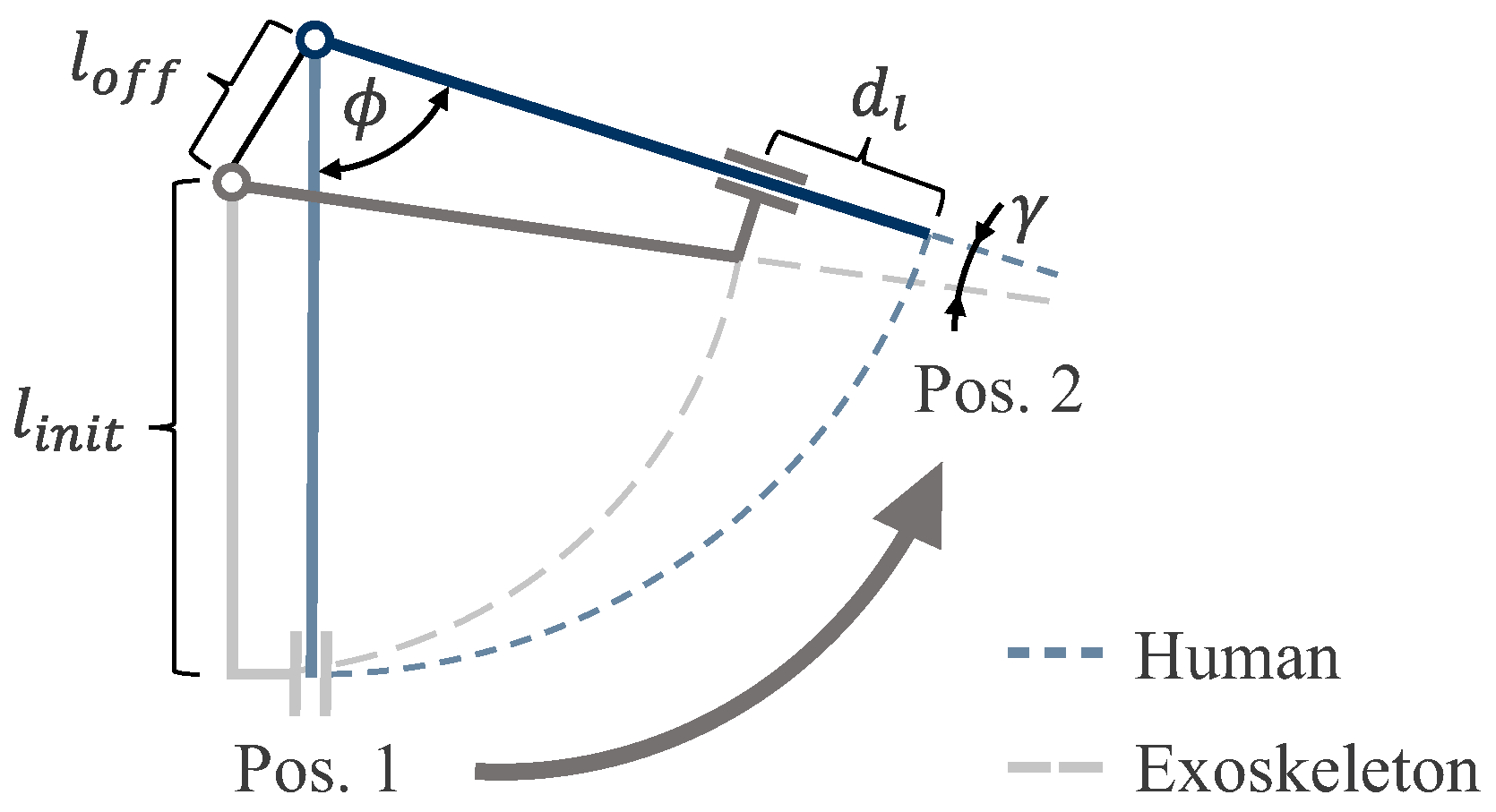
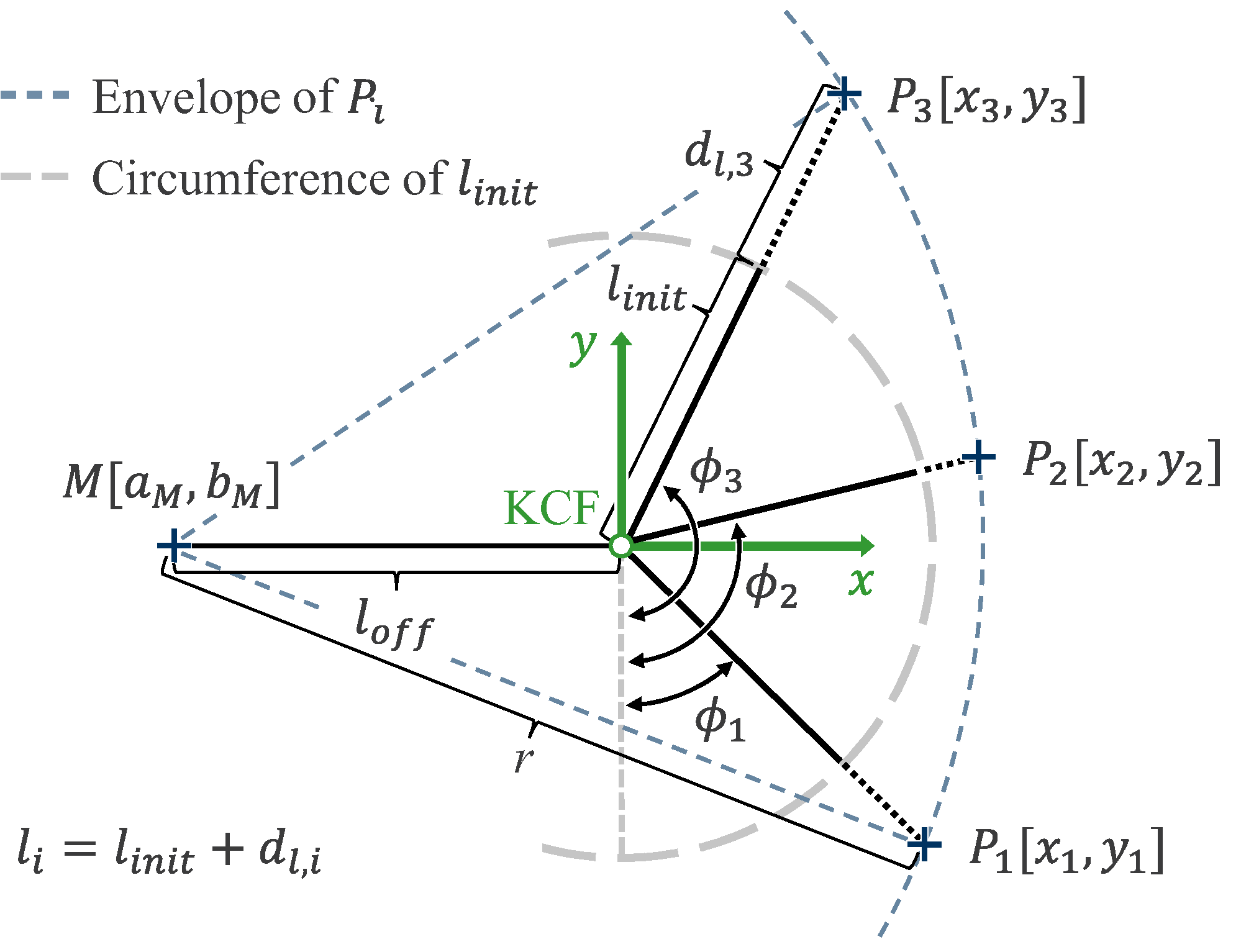
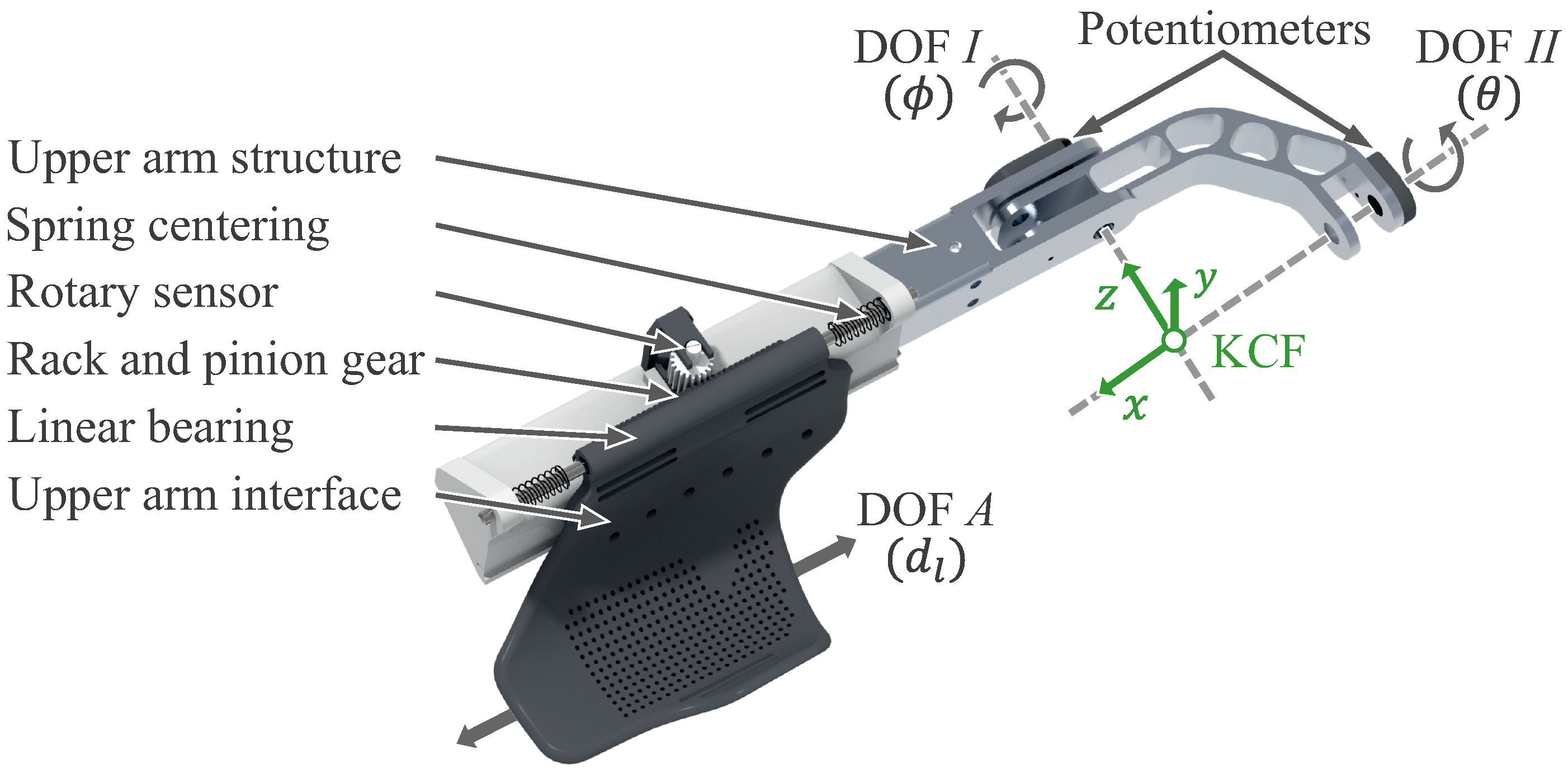
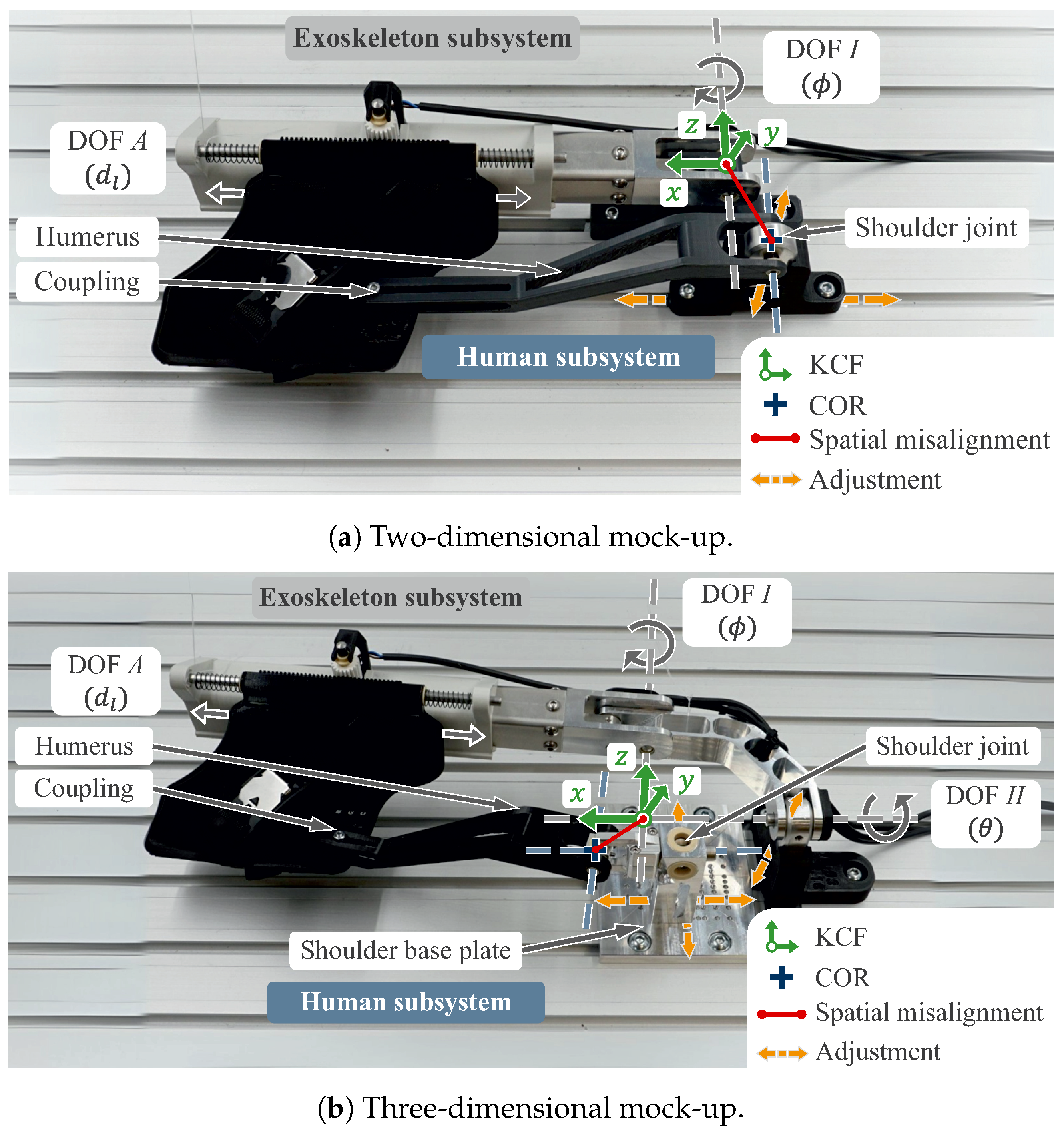


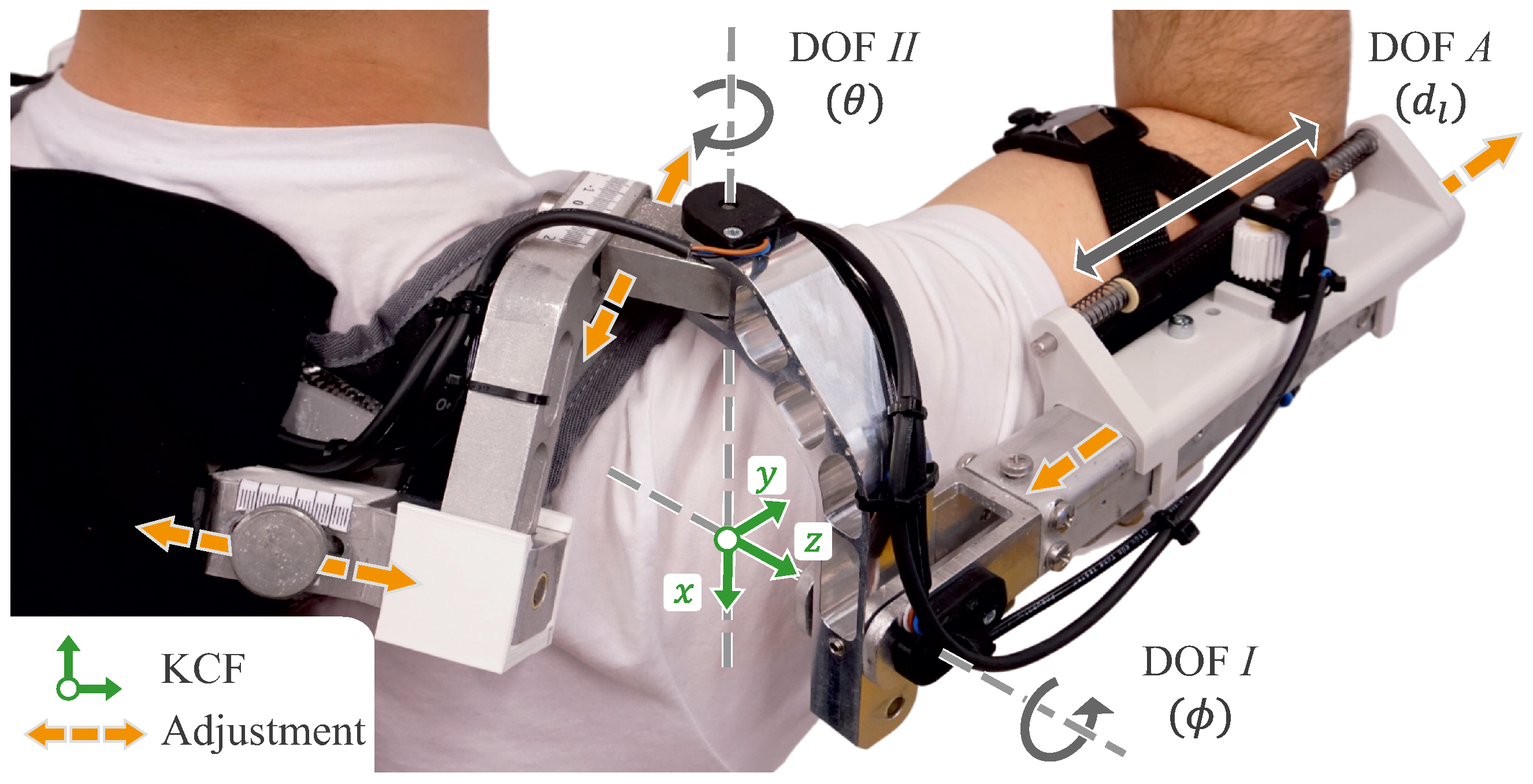
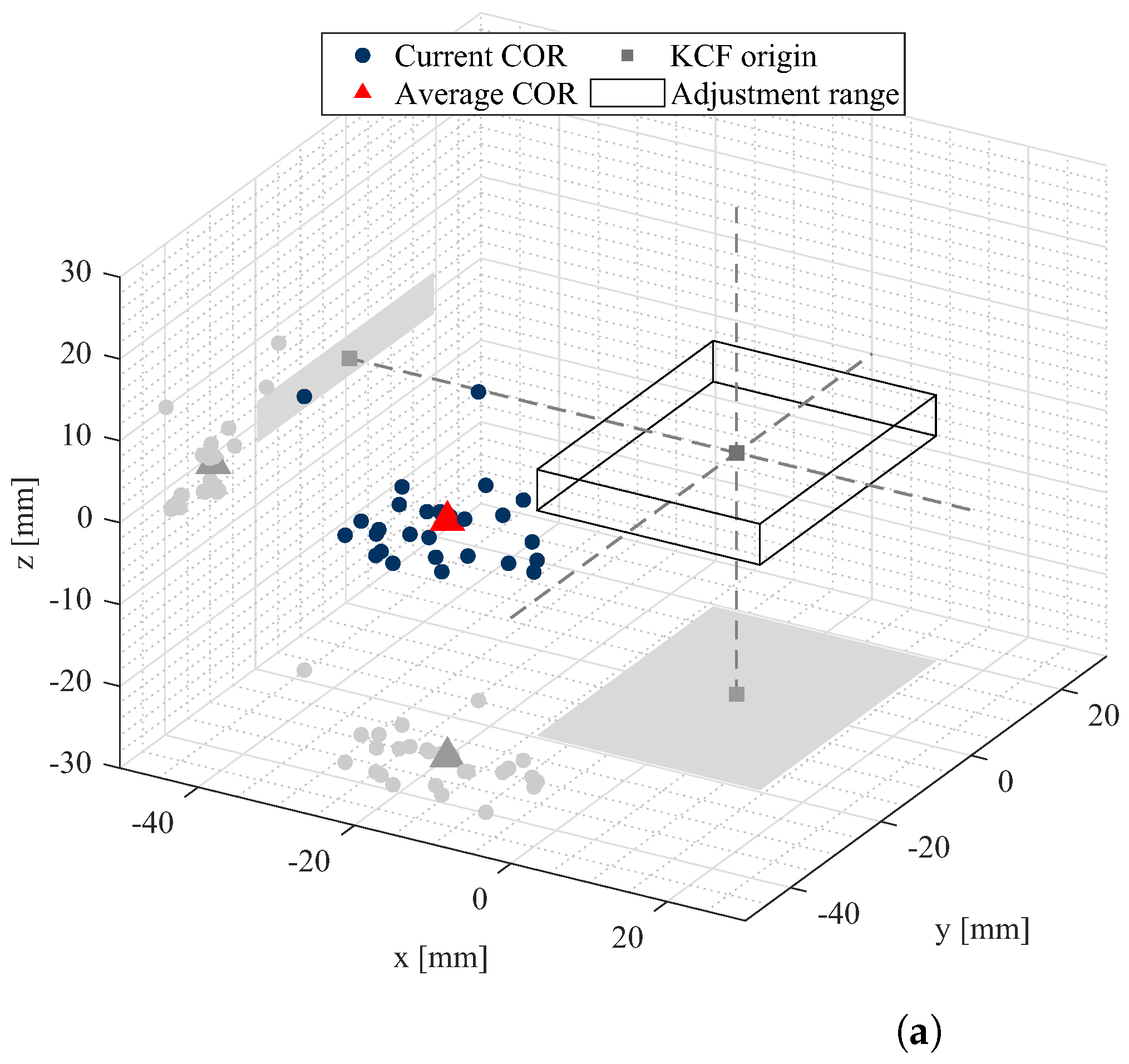
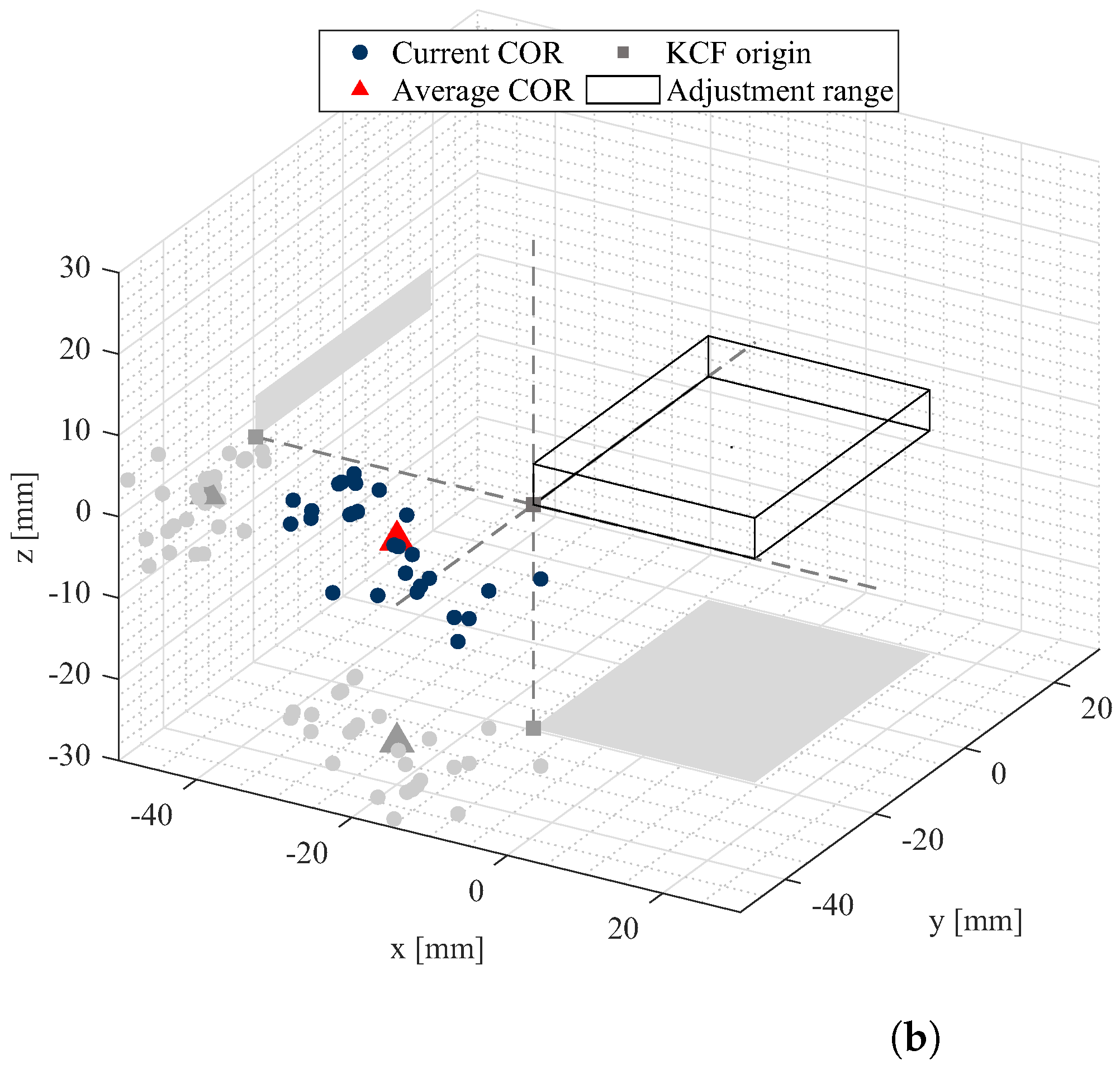
Disclaimer/Publisher’s Note: The statements, opinions and data contained in all publications are solely those of the individual author(s) and contributor(s) and not of MDPI and/or the editor(s). MDPI and/or the editor(s) disclaim responsibility for any injury to people or property resulting from any ideas, methods, instructions or products referred to in the content. |
© 2025 by the authors. Licensee MDPI, Basel, Switzerland. This article is an open access article distributed under the terms and conditions of the Creative Commons Attribution (CC BY) license (https://creativecommons.org/licenses/by/4.0/).
Share and Cite
Ott, O.; Ersoysal, S.; Kraus, N.; Weidner, R. Method for Determining Displacement and Characterizing Spatial Kinematic Misalignment in a Rigid Exoskeleton. Machines 2025, 13, 284. https://doi.org/10.3390/machines13040284
Ott O, Ersoysal S, Kraus N, Weidner R. Method for Determining Displacement and Characterizing Spatial Kinematic Misalignment in a Rigid Exoskeleton. Machines. 2025; 13(4):284. https://doi.org/10.3390/machines13040284
Chicago/Turabian StyleOtt, Oliver, Samet Ersoysal, Niklas Kraus, and Robert Weidner. 2025. "Method for Determining Displacement and Characterizing Spatial Kinematic Misalignment in a Rigid Exoskeleton" Machines 13, no. 4: 284. https://doi.org/10.3390/machines13040284
APA StyleOtt, O., Ersoysal, S., Kraus, N., & Weidner, R. (2025). Method for Determining Displacement and Characterizing Spatial Kinematic Misalignment in a Rigid Exoskeleton. Machines, 13(4), 284. https://doi.org/10.3390/machines13040284





